 original image by Guillermo Aveledo, 4 October 1999,
revised by Esteban Rivera, 7 July 2023
original image by Guillermo Aveledo, 4 October 1999,
revised by Esteban Rivera, 7 July 2023
Last modified: 2024-02-24 by rob raeside
Keywords: caracas | venezuela | lion | santiago cross | regimant | amaranth |
Links: FOTW homepage |
search |
disclaimer and copyright |
write us |
mirrors
 original image by Guillermo Aveledo, 4 October 1999,
revised by Esteban Rivera, 7 July 2023
original image by Guillermo Aveledo, 4 October 1999,
revised by Esteban Rivera, 7 July 2023
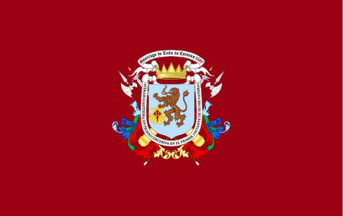 image
by Raul Jesus Orta Pardo, 2 August 2000, revised by Esteban Rivera,
7 July 2023
image
by Raul Jesus Orta Pardo, 2 August 2000, revised by Esteban Rivera,
7 July 2023
Libertador Municipality (Municipio Libertador), City of Caracas
Hustorical Flags:
See also:
"Caracas" is the word used by the aboriginal tribes
which lived on the north coastal regions of the earlier
Venezuela, named for an autochthonous plant called
"Amaranth" in other places of the World. Besides,
this plant was one of their principal sources of nutrition. When
the Spanish conquerors arrived in these lands, they found the
tribes eating it. After inquiries by words and mimics about
the name of the plant, one of the aboriginal understood the
questions of these rare men and standing up, said "CARACARA, CARACAS", and fluttering a bundle of that
herbs at the same time.
Sometimes, the Spanish conqueror's custom was to name the cities
and towns, which they founded during the earlier times of their
dominion over Latin America. However, they composed these names
with autochthonous voices in combination with Spanish holy
sponsors, places or authorities at that times.
According to that tradition, on July 25th, 1567, the Captain
Diego de Losada y Osorio founded the City of "SANTIAGO DE
LEON DE CARACAS" (Saint James of the Lion of Caracas), in
the same place where it exists today , the "Plaza
Boli'var" (Bolivar Square), then called "Plaza
Mayor" (Major Square). Later, the Spanish King Felipe II
(Philippe II) granted to the City their first Coat
of Arms by means of negotiations realized by Don Simo'n de
Bolivar, called "El Viejo" (The older), sixth ancestor
of "El Libertador" SIMON BOLIVAR, our greatest national
hero. These arms only show a brown lion rampant subjecting a
golden scallop with a red St. James Cross inside, all on an
argent (silver) ground. Few years after, it was enriching with a
five points coronet in the crest and war trophies crossed in
saltire at the back in attention to the notable services of their
subjects to the Spanish Crown. By royal schedule signed on March
15th, 1766, the king Carlos III (Charles III) granted to the
Caracas CoA's a pennant with a motto, which express the devotion
of the Caraquenian people for the Holy Mother of God: "AVE
MARIA SANTISIMA SIN PECADO CONCEBIDA EN EL PRIMER INSTANTE DE SU
SER NATURAL" (God Bless You Holiest Mary conceived without
guilt in the first instant of her natural being). Therefore, the
meaning of the Caraquenian CoA its really very simple because it
is "Canting Arms": the golden scallop is representation
of the Apostle Santiago (also called Saint James in English), one
of the holy sponsors of Spain and particularly, for the Spanish
Cavalry; the Lion reminds the Spanish kingdom and the Province of
Leo'n (Lion) where the Conqueror Losada y Osorio was born and
besides, it is an homage for Don Pedro Ponce de Leo'n, Spanish
Governor of the province of Venezuela at that times, who provides
the sources for the successful conquest of the region where was
established the actual Caracas. The argent (silver) ground
represents the Integrity. The golden five points coronet (called
"Coronel" in Spanish) is symbol of Nobility and
Loyalty. The Arms crosses in saltire represents the courage of
the Caraquenian People, whose example of behavior, ever has been
an obligatory reference for the another peoples of Venezuela and
Latin America. So, the full ancient form of the name of the
Capital City of my Country and my birth place too, is "LA
MUY NOBLE Y MUY LEAL SENORIA DE LA CIUDAD MARIANA DE SANTIAGO DE
LEON DE CARACAS" (The Most Noble and Most
Loyalty Seigniory of the Marian City of Saint James of
the Lion of Caracas). In this case,"Marian" has the
meaning of "Devote of the holiest Virgin Mary".
Raul Jesus Orta Pardo, 2 August 2000
The CAPITAL DISTRICT: According to the "Bolivarian
Constitution of Venezuela" (Article 16) recently approved,
it is implicatly abolished the "Federal District" by
the creation of the CAPITAL DISTRICT formed by the same
Municipalities which were in the FD. However, the real dimension
of the City exceed its original limits of the last 60 years and
now also contain the Municipalities of Baruta, Chacao, El Hatillo
and Sucre which belong to the Miranda State.
The "Bolivarian Constitution of Venezuela" establishes,
besides, that the regulations about the matter will be specifying
in a Special Law.
Raul Jesus Orta Pardo, 2 August 2000
The special law on the regime of the Capital District,
hindsighted on the 18th article of this
Constitution, wil be approved by tne National Constituent
Assembly and it will preserve the territorial integrity of the
MIranda State. Meanwhile the law is to be approved, the Organic
Law of the Federal District and the Organic Law of Municipal
Regime."
The National Constituent Assembly issued a Special Law on the
regime of the METROPOLITAN DISTRICT OF CARACAS, on March 8th,
2000. This would make the Constituent Assembly deaf to its own
voice, since:
1. The Constitution dictated that the Assembly would approve a
law for a CAPITAL DISTRICT of CRACAS, not a METROPOLITAN DISTRICT
of CARACAS, which it did.
2. According to the very 'Bolivarian' Constitution they wrote,
the members of the National Constituent Assembly should've known
we can only have a "Metropolitan District": "when
two or more municipalities belonging TO THE SAME FEDERAL ENTITY
have economic, social and phsical relations which would give to
their union the carachteristics of a metropolitan area
(...)".
What happens is that the Municipios Chacao, El Hatillo, Baruta
and Sucre belong to Miranda State, and the Municipio Libertador
(colloquially Caracas) belongs to the Capital District (which
lurks back again, without many explanations, in article 1 of the
special law ). Miranda State and the Federal district are two
separate, distinct, unique entities; this makes the name (and
even the entire law) of the Metropolitan District utterly wrong!!
But that doesn't seem as good enough to make it null and void ...
Although it may seem like a rumbustious "legalese"
complaint, I am sure it will hold many problems for the future,
especially when stating the actual responsabilities of each
municipal government and that of the Metropolitan mayor, and
these frictions will grow when the time comes for the National
Treasure to be distributed and no one caves in: when resources
are scarce, someone will pay attention to the small print, make a
lot of noise and simply refuse to acknowledge the legitimacy of
the resource distribution scheme.
This raises a few vexillological questions
to the fore:
1) Should the METROPOLITAN-CAPITAL (?) DISTRICT of Caracas use
the crimson flag with the Caracas coat of arms?
I would say... NO!! This flag belongs, in any case, to the
Federal District, and, more specifically, to the Municipio
Libertador ("old" Caracas). It never flew on top of the
building of the Governorship of the Federal District (north of
Bolivar Sqare), which only bore the Venezuelan national flag. So,
the Municipio Libertador should keep using the crimson flag as
its own, as it covers the territory of the original Caracas (plus
a few more sq. miles), as it was in 1567. The Alcaldia of the
Municipio Libertador has its own flag
(magenta-blue) and I assume each Municipio has a flag of its
own. In any case, they should, and the "rebranding" of
the city could start that way.
2) Then, is it feasible and historically accurate to give the
'MC?' District of Caracas a flag of its own?
I would think so. A most definite YES for that. As a contemporary
Caraquenian, I believe it should reflect both tradition and
modernity, and the fact that it encompasses not one but five
cities.
Guillermo Aveledo, 11 August 2000
Regarding the (now formal) flag of Caracas, submitted by Guillermo Aveledo on
October 4, 1999 and one by Raul Jesus Orta Pardo on August 2, 2000, based on the
description, the elements of the coat of arms (especially the Order of Santiago
reference) I believe the true flag is the earliest version, which is the one
submitted by Guillermo Aveledo.
Esteban Rivera, 9 July 2023
A burgundy field. With the Caracas coat of arms as badge.
Burgundy has been the city's colour as long as anyone can
remember, but no particular meaning is attached to it. Probably it was a
variation of the colour of the Santiago Cross, emblem of the city. Incidentally,
Venezuela's national football team wears burgundy on their uniform.
Based on the designs shown on the 1981 edition of "Los
Simbolos Sagrados de la Nacion Venezolana", by Francisco A.
Vargas. This is a study on the development of the
Venezuelan flag, coat of arms and anthem, plus a study on the states' coats of
arms
Guillermo Aveledo, 4 October 1999
This flag is for Caracas City but not for the Distrito Federal, that is not
exactly the same. Flag of DF is also red but with DF arms in center (instead the
Caracas ones). In "Vlajka statu a uzemi Sveta" the arms are correct but the
background color (white) is wrong because in fact it is red. DF adopted flag in
c. 1980 and the adoption was made official (according to information
from their representatives in 1989).
Caracas city a has similar flag, but it seems that a variant is
frequently in use (including in official acts): red with white
oval with arms. The white oval was taken from white rectangular cloth manufactured by Bendayan & Cia of Caracas (they make
a white flag with all the states arms, but not for use mainly as
flags but for showing the arms) and attached to a plain
rectangular red flag.
Jaume Ollé, 3 November 1999
That is the Flag of the Municipality of Caracas, and it is the
one flying from the Alcaldía and the Cabildo buildings. So I
assume it is official. Yet there is no such thing as an official
ruling on this matter by the Concejo Municipal. The DF
Government which governs a portion of territory now identical to
that of the Municipality of Caracas (actually, Municipio
Libertador), has no flag flying from its offices nor inside its
buildings. They use the Venezuelan State Flag, being a branch of
the Central Executive and an office appointed by the President
himself. The background for the Municipality flag is NOT red, but
burgundy, vino tinto, grana, and has not any white oval. However,
the flag hoisted on the Municipality buildings is quite old and
deteriorated and I could be wrong.
Guillermo Aveledo, 4 November 1999
With regards to the Caraquenian Municipality Flag, it is the
same as shown above but it is charged with the coat of arms in full colors at
the center. The burgundy red of their ground reminds us of the
courage of the Caraquenians and their blood leaked for the cause
of the Independence of Venezuela.
Raul Jesus Orta Pardo, 2 August 2000
Recently I was in the administrative building of the
Libertador Municipality and I could see that the version of the flag and the
coat of arms in this page are not the previous but the actual
and effective symbols of Caracas and I had a conversation with a
municipal official who confirmed it.
Raul Jesus Orta Pardo, 25 August 2000
The Flag of Caracas consists of a burgundy red field with the
version of the coat of arms of the City effective since the
decade of the 1980s. The red field, from the predominant
color in the royal pennants of colonial Caracas, symbolizes the
blood spilled by Caraquenian people in favor of independence
and the highest ideals of the Venezuelan nation. The original
design of the Caracas fag appeared in the 1980s and
consisted of a burgundy red cloth with the version of the then
adopted and still effective coat of arms located in the canton.
Later in 1994, approximately, and presumably as a result of the
change of municipal authorities, it was decided to place the
Caracas coat of arms with slightly increased size on the center of the
field, a configuration that has been maintained at the present time.
Raul Jesus Orta Pardo, 21 May 2002
 image from
www.bnv.bib.ve,
located by Dov Gutterman, 19 May 2002
image from
www.bnv.bib.ve,
located by Dov Gutterman, 19 May 2002
The flag that was the first one of Libertador Municipality
whose capital is Caracas and was used during the final part of
the 1980s. Its color is not mulberry but red dark, similar to
the current one where the coat of arms of Caracas
appears in the center. The source of information in the site is a
poster made by a flag manufacturing company located in Caracas
whose information lamentably does not have to be considered
totally valid.
Raul Orta, 19 May 2002
Wikipedia in Spanish says that the Capital District, as well as the
"Municipio Bolivariano Libertador de Caracas" have changed their flag and emblem
since April 13, 2022.
I could not manage to see it on the official website
but a photo (published in June 2022) shows two flags beside the national one,
one I can't identify, the other one for the Gobierno.
Links:
https://www.gdc.gob.ve/sistema/backend/images/noticias/883_1.jpg
https://en.wikipedia.org/wiki/Caracas
https://upload.wikimedia.org/...Flag_of_Caracas_%282022%29.svg.png
https://es.wikipedia.org/wiki/Escudo_de_Caracas
Jean-Marc Merklin,
7 July 2023
The flags you mention, from left to right are:
- Venezuela
- Gobierno
del Distrito Capital (English: Government of the Capital District) (Executive
power) (since 2009, sources:
https://es.wikipedia.org/wiki/Concejo_Municipal_de_Libertador and
https://en.wikipedia.org/wiki/List_of_Venezuela_governors#Other_authorities)
- Instituto de Altos Estudios del Pensamiento del Comandante Supremo Hugo Rafael
Chávez Frías (English: Institute of Advanced Studies of the Thought of the
Supreme Commander Hugo Rafael Chávez Frías) (a think tank)
As you
mentioned, Caracas has adopted new symbolism on the date you mentioned in
commemoration of the 20th anniversary of the ill-fated coup d'etat against Hugo
Chávez: the Concejo Municipal (English: Municipal Council) approved by a local
ordinance.
Source:
https://twitter.com/gestionperfecta
The coat of arms was designed by
Ómar Cruz and the flag was designed by Víctor Hernán Rodríguez Durán (another
source mentions Víctor Hernández:
https://www.notitarde.com.ve) and Carolina Jiménez Jiménez.
Sources:
http://concejomunicipalbolivarianolibertador.blogspot.com,
https://eldiario.com/2022/04/13/nuevos-simbolos-de-caracas-concejo-municipal
https://es.wikipedia.org/wiki/Escudo_de_Caracas
On March 8, 2000,
the year after a new constitution was introduced in Venezuela, it was decreed in
Gaceta Official N° 36,906 that the Metropolitan District of Caracas, also known
as Gran Caracas would be created and that some of the powers of municipalities
would be delegated to the Alcaldía Mayor, physically located in the large
Libertador municipality, in the center of the city. The Metropolitan District of
Caracas was suppressed on December 20, 2017 by the Constituent National Assembly
of Venezuela. This is the Mayor's Office flag - see Mayor's
Office.
The new coat of arms features images of the liberator Simón
Bolívar, an African American woman and the Cacique Guaicaipuro over the Waraira
Repano (Avila Hill), as well as the Sword of the Founding Father, a spear and a
red star in representation of the Bolivarian Revolution, together with several
natural elements seen in the city such as pyre leaves and a macaw, featuring the
slogan "Seguid el ejemplo que Caracas dio" (English: Follow the example that
Caracas set), and below a broken chain surrounded by the dates 1810-1811 (the
first attempt by a South American colony to seek independence from Spain) and
1989-2002 (the
period of civil and political unrest in the country which saw
two coup d'etat attempts by Hugo Chávez, the impeachment of the President,
elections in which Chávez won the Presidency through the MVR party and the
promulgation of the new Constitution), whereas the flag features the white star
which represents light, rebellion and glow, together with the red color which
stands for passion and patriot blood, besides green, white and blue seen on the
Caracas landscape.
Sources:
https://www.notitarde.com.ve
and
https://twitter.com/concejocaracas/
Esteban Rivera, 9 July 2023
Here are Caracas, Venezuela, coats of arms (the real thing.....not just an image) www.une.edu.ve, and choose: Historia de Caracas .
Dov Gutterman, 4 November 1998
Current Caracas Coat of Arms
ccs02.gif) image
by Raul Jesus Orta Pardo, 2 August 2000
image
by Raul Jesus Orta Pardo, 2 August 2000
The Seal or coat of arms consists on a brown lion rampant, on a silver field,
holding in its arms a golden lode [it looks more like a shell, and that is how
its depicted in the City Hall's Stationery], adorned with war trophies. On March
15th, 1776, King Charles III of Spain, through a Royal Cedula, conceded Caracas
the right to wear a border which reads: "Ave Maria Purisima, Sin Pecado Concebida
en el Primer Instante de su Ser Natural" (more or less: "Holiest Mary, Conceived
Free of Sin on the First Instant of Her Natural Being"). Mary is the
matron of Caracas based on the designs showed on the 1981 edition of "Los
Simbolos Sagrados de la Nacion Venezolana", by Francisco A. Vargas. This is a
study on the development of the Venezuelan flag, coat of arms and anthem,
plus a study on the states' coat of arms.
Guillermo Aveledo, 4 October 1999
This image shows the further and official version of the
Caracas coat of arms, which appears in the ends of the 1980s, including the
novelty of the ancient foundational name of Caracas and its
foundation year "Santiago de Leon de Caracas - 1567"
over the crest wrote inside a pennant.
Raul Jesus Orta Pardo, 2 August 2000
The Caracas' coat of arms have been versioned sometimes
maintaining its main heraldic elements. There are nonofficial but
relatively popular versions of the Caracas coat of arms between 1950 and
1970, approximately, that also reproduces Mr. Ottfried Neubecker
work "A Guide to Heraldry" jointly with the Arms of the
main cities of the world. The terrace of Vert (green) and the
replacing of the scallop by a little oval escutcheon has been net
artistic licenses that are not blazoned or described officially
like part of the coat of arms of Caracas. In the optics of the
heraldic treatment of the image, it has had happy and unfortunate
versions and in our modest opinion the present one this just in
the middle of the ends. Be worth to say that according to the
respective Canon, the lambrequins always must have enamels of the
heraldic field and when are many, is chosen by most important.
Also, these ornaments are located from the Chief or upper part of
the Coat of Arms and in some cases, appear too at the flanks of
the Chief because lambrequins are reminding of the mantles or
little mantles with which the helmets were covered in first term
for refresh them of the high temperatures and in second case to
adorn them with distinguishing character. Naturally, it become
shreds when their carriers had fought and those shreds are
exactly those that heraldic treatment turns to lambrequins. A
magnificent example of how it must be represented appears in the
Coat of Arms of Bahrain. If we compared it with the one of
Caracas, we will appreciate that the lambrequins are
multi-chromatics and are located under the war trophies at the
base flanks of the field... With regards to the gray and white,
as we know in Heraldry represent the same enamel indifferently:
the Argent or Silver. And the field on the Caracas Arms is
Argent.
The Coat of Arms of the City of Caracas was adopted by the
Libertador Municipality to identify itself and later the
Metropolitan Mayor Office assumed the lion, the scallop and the
St. James Cross for the same aim. Symbollogically speaking, this
raised a conflict then that Caracas identifies the Coat of
Arms of the Capital of the Republic?
In our modest opinion, it is necessary to determine the specific
scope that identifies the Caracas coat of arms then although is certain
that Baruta, Chacao, El Hatillo and Sucre (Petare) belongs to
Miranda State, also are Caracas; or better still, part of the so
called "Great Caracas". If we rely on the Symbollogical
Protocol, the Symbols of the Municipalities before mentioned
theoretically are subordinated to the Caracas ones by antiquity
and so that the expansion of the metropolis absorbed them in the
way. But, as we mentioned in some occasion, the Symbollogy in
Venezuela is taking it first steps although the Symbollogical
reality in the states, municipalities and other places of my
country has come accentuating since the decade of 1990.
Raul Jesus Orta Pardo, 30 May 2002
The arms were granted on September 4th, 1591 (https://ifc.dpz.es/recursos/publicaciones/30/55/20alfaro.pdf) by the Spanish Crown to Simón de Bolívar “el Mozo” (English: Simón de Bolívar, the handsome), sixth ancestor of El Libertador Simón Bolívar, the greatest national hero. The early arms only show a brown lion rampant subjecting a golden scallop with a red St. James Cross inside, all on a silver ground. The arms were crowned by a five pointed crown. The arms are canting, the official name of the city was Santiago de León de Caracas (Saint James of León of Caracas). The lion is canting for the León part, the scallop is the symbol of St. James and the cross is the cross of the (Spanish) Order of Santiago. The additions around the shield were added on March 13, 1766. The shield is surrounded by war trophies crossed in saltire at the back, and a motto "Ave Maria Santisima Sin Pecado Concebida en el Primer Instante de su Ser Natural" (Blessed most holy Mary conceived without guilt in the first instant of her natural being). The second motto above the arms with the official name of the city and its foundation year : "Santiago de León de Caracas - 1567".
For additional information go to Caracas (official website):
http://www.caracas.gob.ve/ (currently unaccessible, available only through
here: http://www.caracas.gob.ve/)
Esteban Rivera, 9 July 2023
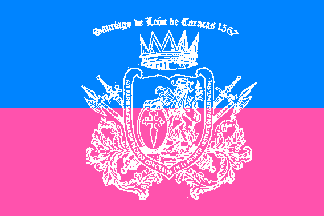 image
by Guillermo Aveledo, 1 March 2000
image
by Guillermo Aveledo, 1 March 2000
Here is the flag of the Alcaldía (Mayor's Office) of the City
of Caracas, or of what its know as such. Caracas has four mayors:
the Mayor of Municipio Libertador (a.k.a mayor of Caracas; being
the mayor of the Federal District); the mayor of Municipio Chacao
(both the mayor and the municipio have a flag), the Mayor of
Municipio Baruta, and the Mayor of Municipio Petare. To add more
to this confusing stew, there will be a new official, the Alcalde
Mayor (or Higher
Mayor?), who might have a flag. In any case, the flag of
Caracas shown above stands for what is the old city (Caracas, in
strictu senso; used by the City Hall), and this one stands of the
flag of the Municipio Libertador's Mayor's Office. Caracas, or
even, Greater Caracas, is not a regularised political entitity,
although it is a city all with those municipios (plus some extra
municipios on suburban areas). The Alcalde Mayor will rule above
these municipios' mayors and over all those municipios. This flag, then, is the flag of the Mayor of the Municipio Libertador
(a.k.a Mayor of Caracas). It is a 2:3 flag, two bands of blue and
magenta, with an outline (white) of the coat of arms of Caracas, using the
caption which crowns the coat of arms (not to be seen on the City of
Caracas flag, which uses the same coat of arms): "Santiago de Leon de
Caracas 1567", the Spanish name and date of foundation of
the city.
Guillermo Aveledo, 1 March 2000
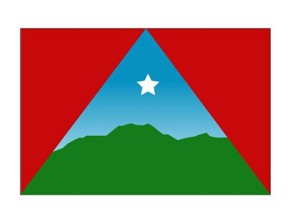 images located by Esteban
Rivera, 9 July 2023
images located by Esteban
Rivera, 9 July 2023
Source: https://maduradas.com
.jpg) images located by Esteban
Rivera, 9 July 2023
images located by Esteban
Rivera, 9 July 2023
Source: https://maduradas.com/
Flag and coat of arms of the Metropolitan Police at www.pm.gov.ve.
A blue flag with the arms centered.
Dov Gutterman, 15 April 2004
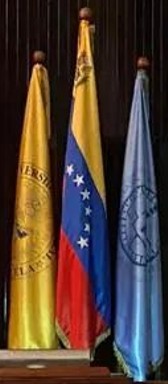 image located by Paul Bassinson,
17 May 2023
image located by Paul Bassinson,
17 May 2023
The yellow flag states "universidad" and the blue flag carries the hospital logo.
Source:
https://www.facebook.com/photo
Paul Bassinson, 17 May 2023

.gif) images located by Esteban
Rivera, 9 July 2023
images located by Esteban
Rivera, 9 July 2023
Sources:
https://www.gdc.gob.ve/sistema/frontend/
https://reportero24.com/2013/12/18/alexander-cambero-tarzan-y-los-ojos-del-muerto/
For additional information go to Instituto de Altos Estudios del Pensamiento del
Comandante Supremo
Hugo Rafael Chávez Frías (official websites):
https://aulahugochavez.org.ve
and
http://todochavez.gob.ve/el-instituto/
Esteban Rivera, 9 July 2023
Capital District Government

.gif) images located by Esteban
Rivera, 9 July 2023
images located by Esteban
Rivera, 9 July 2023
Sources:
https://www.gdc.gob.ve
https://seeklogo.com/vector-logo/213066/gobierno-del-distrito-capital
For additional information go to Gobierno Distrital de Caracas (official
website)
https://www.gdc.gob.ve/
Esteban Rivera, 9 July 2023
Caracas Council logo
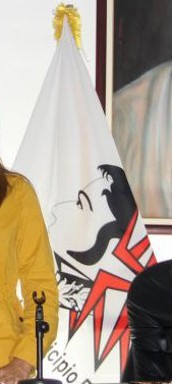
.gif) images located by Esteban
Rivera, 9 July 2023
images located by Esteban
Rivera, 9 July 2023
Sources:
http://concejomunicipalbolivarianolibertador.blogspot.com
https://www.legislaturasconectadas.gob.ar/Legislatura/124/Concejo-Municipal-de-Caracas
For additional information go to Concejo Municipal de Caracas (official
website):
http://concejomunicipalbolivarianolibertador.blogspot.com
Esteban Rivera, 9 July 2023
Mayorship of Caracas (former logo)
.gif) image located by Esteban
Rivera,, 9 July 2023
image located by Esteban
Rivera,, 9 July 2023
Source: https://twitter.com/AlcaldiaDCcs
Current logo
.gif) image located by Esteban
Rivera, 9 July 2023
image located by Esteban
Rivera, 9 July 2023
Source: https://www.logotypes101.com/.../alcaldiadecaracas.png
Even though this new logo was in use since February 20, 2010 (http://jorgerodriguez.psuv.org.ve)
when Jorge Rodríguez was in office (November 30, 2008 - November 3, 2017)
official publications up to even 2015 still displayed the old logo.
Esteban
Rivera, 9 July 2023